Mechanisms of Insulin Action and Insulin Resistance
- PMID: 30067154
- PMCID: PMC6170977
- DOI: 10.1152/physrev.00063.2017
Mechanisms of Insulin Action and Insulin Resistance
Abstract
The 1921 discovery of insulin was a Big Bang from which a vast and expanding universe of research into insulin action and resistance has issued. In the intervening century, some discoveries have matured, coalescing into solid and fertile ground for clinical application; others remain incompletely investigated and scientifically controversial. Here, we attempt to synthesize this work to guide further mechanistic investigation and to inform the development of novel therapies for type 2 diabetes (T2D). The rational development of such therapies necessitates detailed knowledge of one of the key pathophysiological processes involved in T2D: insulin resistance. Understanding insulin resistance, in turn, requires knowledge of normal insulin action. In this review, both the physiology of insulin action and the pathophysiology of insulin resistance are described, focusing on three key insulin target tissues: skeletal muscle, liver, and white adipose tissue. We aim to develop an integrated physiological perspective, placing the intricate signaling effectors that carry out the cell-autonomous response to insulin in the context of the tissue-specific functions that generate the coordinated organismal response. First, in section II, the effectors and effects of direct, cell-autonomous insulin action in muscle, liver, and white adipose tissue are reviewed, beginning at the insulin receptor and working downstream. Section III considers the critical and underappreciated role of tissue crosstalk in whole body insulin action, especially the essential interaction between adipose lipolysis and hepatic gluconeogenesis. The pathophysiology of insulin resistance is then described in section IV. Special attention is given to which signaling pathways and functions become insulin resistant in the setting of chronic overnutrition, and an alternative explanation for the phenomenon of ‟selective hepatic insulin resistanceˮ is presented. Sections V, VI, and VII critically examine the evidence for and against several putative mediators of insulin resistance. Section V reviews work linking the bioactive lipids diacylglycerol, ceramide, and acylcarnitine to insulin resistance; section VI considers the impact of nutrient stresses in the endoplasmic reticulum and mitochondria on insulin resistance; and section VII discusses non-cell autonomous factors proposed to induce insulin resistance, including inflammatory mediators, branched-chain amino acids, adipokines, and hepatokines. Finally, in section VIII, we propose an integrated model of insulin resistance that links these mediators to final common pathways of metabolite-driven gluconeogenesis and ectopic lipid accumulation.
Figures

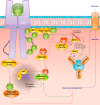



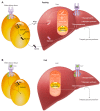

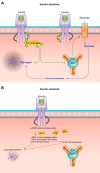



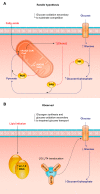

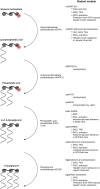





Similar articles
-
Sphingolipids as a Culprit of Mitochondrial Dysfunction in Insulin Resistance and Type 2 Diabetes.Front Endocrinol (Lausanne). 2021 Mar 18;12:635175. doi: 10.3389/fendo.2021.635175. eCollection 2021. Front Endocrinol (Lausanne). 2021. PMID: 33815291 Free PMC article. Review.
-
Diabetes and branched-chain amino acids: What is the link?J Diabetes. 2018 May;10(5):350-352. doi: 10.1111/1753-0407.12645. Epub 2018 Feb 13. J Diabetes. 2018. PMID: 29369529
-
Mechanisms of muscle insulin resistance and the cross-talk with liver and adipose tissue.Physiol Rep. 2020 Oct;8(19):e14607. doi: 10.14814/phy2.14607. Physiol Rep. 2020. PMID: 33038072 Free PMC article. Review.
-
Identification of potential bioactive compounds and mechanisms of GegenQinlian decoction on improving insulin resistance in adipose, liver, and muscle tissue by integrating system pharmacology and bioinformatics analysis.J Ethnopharmacol. 2021 Jan 10;264:113289. doi: 10.1016/j.jep.2020.113289. Epub 2020 Aug 23. J Ethnopharmacol. 2021. PMID: 32846191
-
The Effects of BCAAs on Insulin Resistance in Athletes.J Nutr Sci Vitaminol (Tokyo). 2019;65(5):383-389. doi: 10.3177/jnsv.65.383. J Nutr Sci Vitaminol (Tokyo). 2019. PMID: 31666474 Review.
Cited by
-
Sarcopenia and mortality risk in community-dwelling Brazilian older adults.Sci Rep. 2022 Oct 20;12(1):17531. doi: 10.1038/s41598-022-22153-9. Sci Rep. 2022. PMID: 36266412 Free PMC article.
-
Insulin signaling and glucose metabolism in different hepatoma cell lines deviate from hepatocyte physiology toward a convergent aberrant phenotype.Sci Rep. 2020 Jul 21;10(1):12031. doi: 10.1038/s41598-020-68721-9. Sci Rep. 2020. PMID: 32694512 Free PMC article.
-
The regulatory role of insulin in energy metabolism and leukocyte functions.J Leukoc Biol. 2022 Jan;111(1):197-208. doi: 10.1002/JLB.2RU1220-847R. Epub 2021 Mar 16. J Leukoc Biol. 2022. PMID: 33724523 Free PMC article. Review.
-
Human islet amyloid polypeptide: A therapeutic target for the management of type 2 diabetes mellitus.J Pharm Anal. 2022 Aug;12(4):556-569. doi: 10.1016/j.jpha.2022.04.001. Epub 2022 Apr 7. J Pharm Anal. 2022. PMID: 36105173 Free PMC article. Review.
-
GLP-1 Agonist to Treat Obesity and Prevent Cardiovascular Disease: What Have We Achieved so Far?Curr Atheroscler Rep. 2022 Nov;24(11):867-884. doi: 10.1007/s11883-022-01062-2. Epub 2022 Aug 31. Curr Atheroscler Rep. 2022. PMID: 36044100 Review.
References
-
- Abulizi A, Perry RJ, Camporez JPG, Jurczak MJ, Petersen KF, Aspichueta P, Shulman GI. A controlled-release mitochondrial protonophore reverses hypertriglyceridemia, nonalcoholic steatohepatitis, and diabetes in lipodystrophic mice. FASEB J 31: 2916–2924, 2017. doi:10.1096/fj.201700001R. - DOI - PMC - PubMed
-
- Adams SH, Hoppel CL, Lok KH, Zhao L, Wong SW, Minkler PE, Hwang DH, Newman JW, Garvey WT. Plasma acylcarnitine profiles suggest incomplete long-chain fatty acid β-oxidation and altered tricarboxylic acid cycle activity in type 2 diabetic African-American women. J Nutr 139: 1073–1081, 2009. doi:10.3945/jn.108.103754. - DOI - PMC - PubMed
Publication types
MeSH terms
Substances
Grants and funding
LinkOut - more resources
Full Text Sources
Other Literature Sources
Medical

